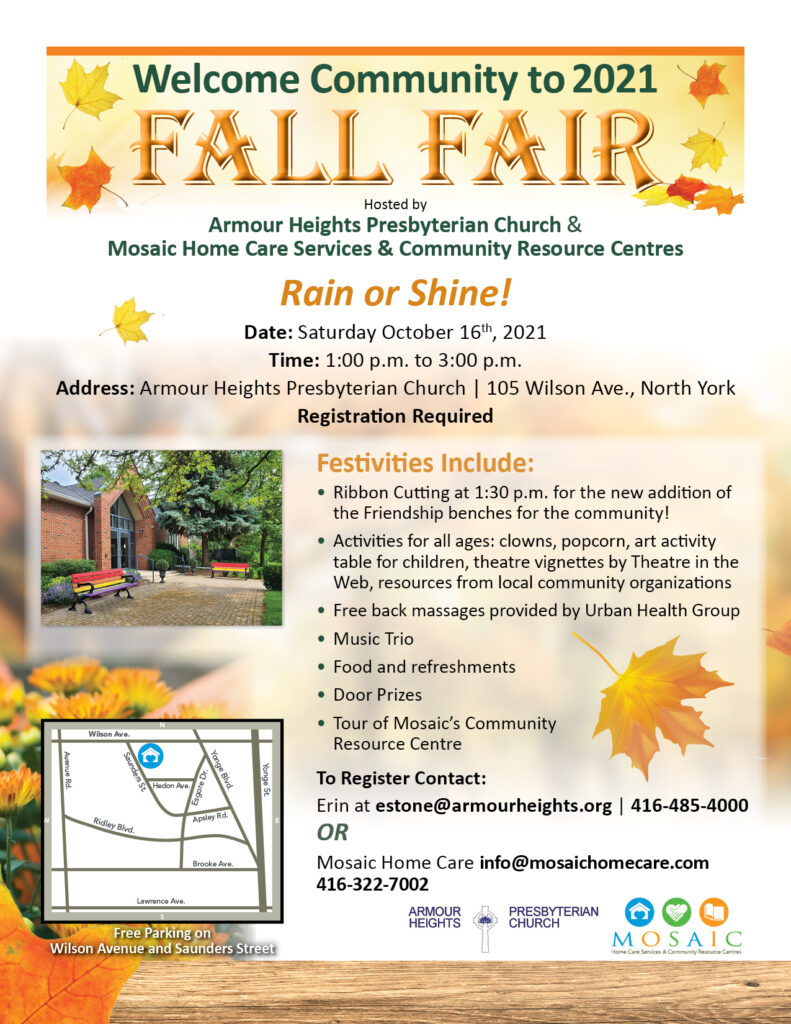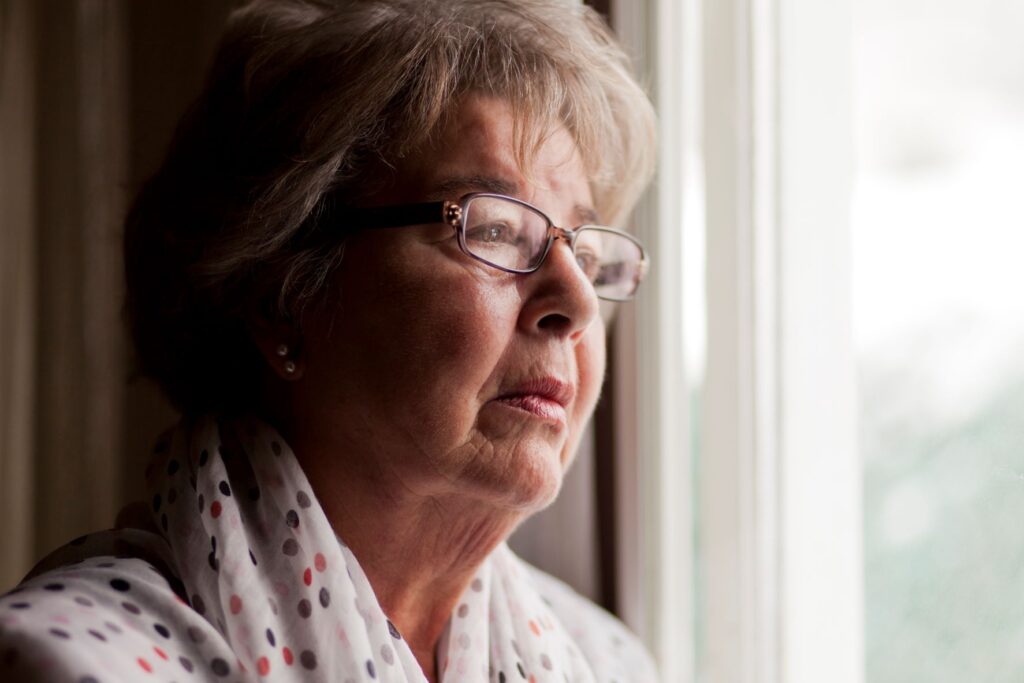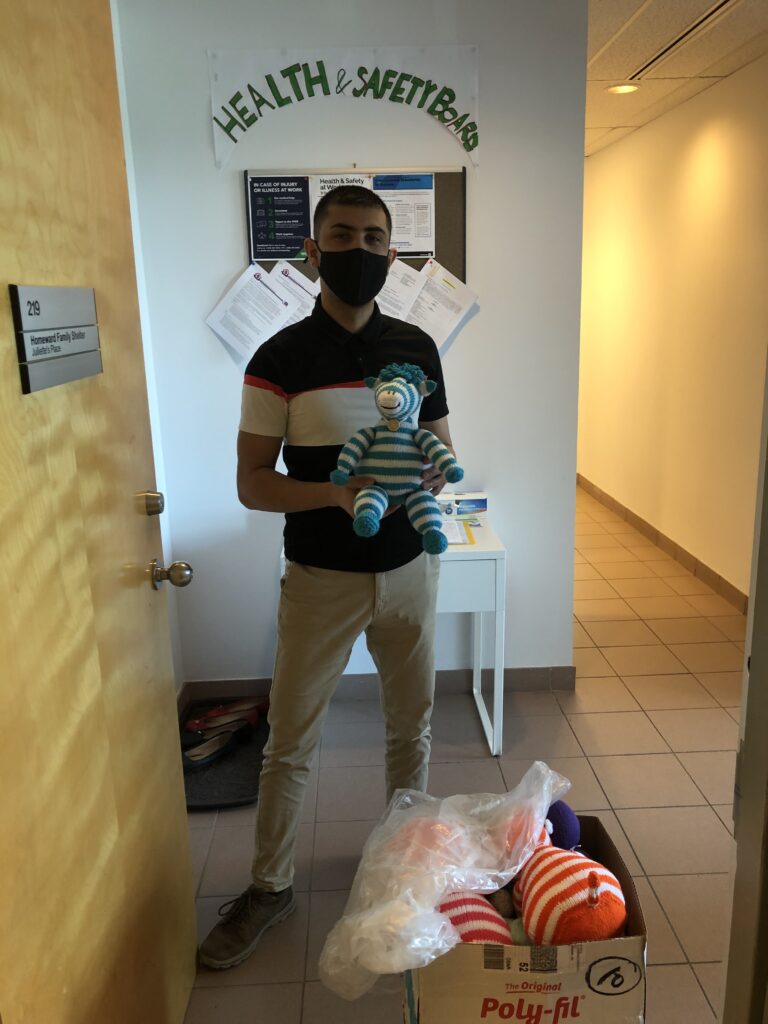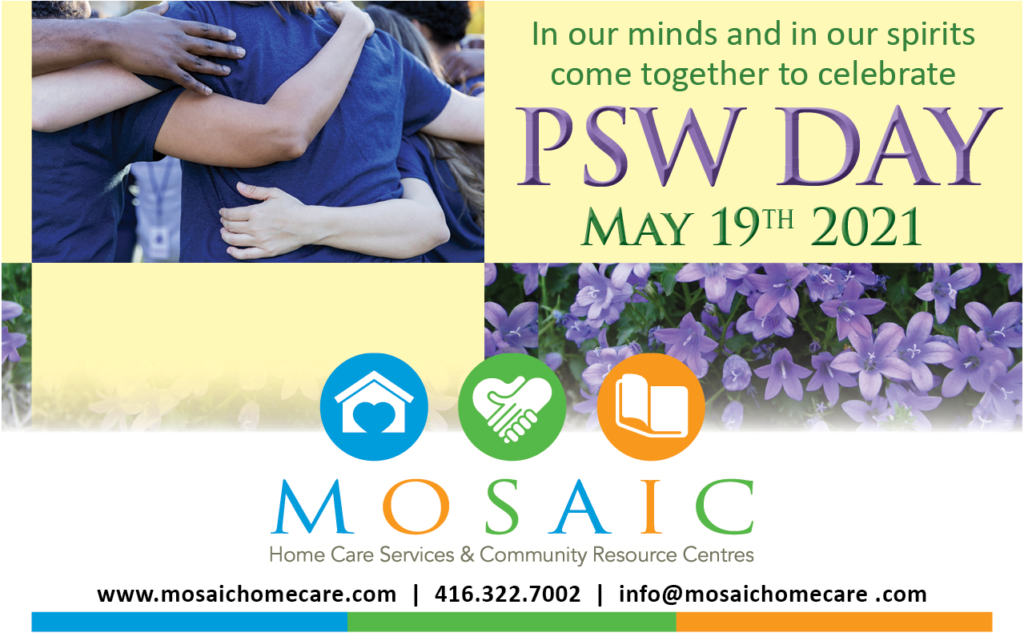The Community Fall Fair and our New Website
Welcome to Fall our most recent newsletter, Mosaic’s New and Improved Website & our Community Fall Fair with Armour Heights Presbyterian Church.

We would like to draw your attention to some very important updates with regards to our Fall Newsletter with our many social programs, events, new services and articles.

Our new website includes Mosaic’s Social Club Events, a Family Caregiver Corner, information on specialized services, as well as details on Person Centered Care, “The Meaning of Me®” and Elder Care Plus® Family Counselling Social Work & Navigation Services. You will also find a full listing of our on-line events.
If you would like to be added to receive our newsletter by email or by post visit our website at www.mosaichomecare.com and fill in the contact information. You can also add your own name to the sign-up for the newsletter as well. Newsletter – Mosaic Home Care
Our Community Fall Fair will be a joint event with Armour Heights Presbyterian Church on Saturday October 16th, 2021 from 1:00 p.m. to 3:00 p.m.
Although to be held outside, we encourage face masks to be worn and that people submit to contact tracing. See our flyer for more information below. Mosaic has contributed to Armour Heights Presbyterian Church one of the two special benches. These benches are called “Friendship Benches”, they first started in Zimbabwe, Africa. Two benches were placed just outside Armour Heights Church. The benches are colourful, inclusive, create a safe space, a sense of belonging and are intended to encourage community interaction and empathic interaction.
If you want to register for any of the programs or the Fall Fair please fill out the contact us on our website and we will respond to your email with regards to registration.
Mosaic Management Team.
Reducing Loneliness for Healthy Ageing, by Tara Keck, Professor of Neuroscience
Loneliness and its effects on well-being have gotten a lot of attention lately because of the COVID-19 pandemic and restrictions on social interactions. But what do scientists know about loneliness and its risks?

Loneliness can be used to describe many different feelings and situations. Scientists generally think about loneliness as having two linked components. The first is ‘emotional loneliness[1]’, which occurs when a person lacks close relationships and confidants. In other words, Do you have strong relationships with people who support you? Are there people that you can talk to when you’re feeling good or bad?
The second component is called ‘Social loneliness[2]’, which occurs when a person lacks an extensive social network. Here the main question is, Do you have enough social interactions and do you generally feel like a part of the community? This component reflects our more casual interactions, like friendly talks with people you encounter in your day-to-day life. Even though these interactions are less deep, they help us feel like we belong to our communities.
Of course, these two different measures are often related to each other for individuals, but changes that occur during ageing may affect one area more than another. For example, having close family members or friends move away or die may more strongly affect emotional loneliness. On the other hand, retirement would reduce the number of casual social interactions that you have at work, while an illness that affects mobility may make it harder to attend regular social events. Both of these would have a bigger effect on social loneliness. Some life events can affect both. For example, hearing loss may reduce your ability to understand others, which could affect the closeness of your relationships. It may also make casual social interactions more difficult and make you more likely to avoid these situations.
Both components of loneliness are important for healthy ageing, but they pose different critical risks for health and well-being. A lack of quality social relationships is linked to increases in cardiovascular disease[3] and depression[4], and is a risk factor for dementia[5]. A reduced social network has been shown to have increase mortality and decrease life span in older people. It may seem surprising, but the effects of loneliness are just as strong as those of smoking, obesity, and physical inactivity[6]. So, it’s really important to maintain strong emotional and social relationships.
How much social interaction is ideal to combat loneliness? There isn’t one right answer because it depends on how often you feel lonely. If you do feel lonely, you aren’t alone. In a recent study we conducted[7], more than 75% of older people reported that they often feel lonely. This high level of reported loneliness in older people is consistent with reports from many countries1.
What can you do if you are feeling lonely? Unfortunately, there are not yet a lot of scientifically tested approaches to address loneliness. We’re in the process of running a survey to help us develop ways to overcome loneliness, particularly in older people. In the meantime, there are a few steps you can take to figure out what type of loneliness you are experiencing. To test out whether you are feeling socially or emotionally lonely, you can make an effort to have a few more social engagements, either group meetups or one-on-ones (in a pandemic-safe way of course). If more social interactions are not helping, then you might need to work on developing deeper relationships.
The key point to remember is that social interactions are a critical part of our well-being and should be considered as important as our diet and exercise. Making sure we have regular social interactions, even if they have to be virtual, is key for maintaining our health as we age.
Tara Keck, Professor of Neuroscience
[1] Masi et al., 2011
[2] Domenech-Abella et al., 2017
[3] Knox and Uvnas-Modberg, Psychol Bull, 1998; Yang et al., Proc Natl Acad Sci, 2016
[4] Santini et al., J Affect Disord, 2015
[5] Livingston et al., The Lancet, 2017
[6] Holt-Lundstad et al., PLoS Medicine, 2010
[7] https://ba.unfpa.org/en/publications/changes-behaviors-and-projected-health-benefits-members-healthy-ageing-centres-bosnia
Community Creates Cuddly Critters for Homeward Family Shelter (Juliette’s Place)
Mosaic’s knitters have a long history of donating their creations to the community. On Friday 30th July Beth Eshete, Mosaic’s Community and Social Resource Engagement Coordinator dropped off an amazing troupe of cuddly animals to Juliette’s Place (thank you Simone and Ilkin at Juliette’s Place).

In Beth’s own words: “Last Friday I had the privilege of dropping off some lovely knitted stuffed animals, donated and created by one of our Mosaic knitters, to a local family shelter. Ruth has been working on her critters for some time and since she is homebound due to health reasons she did not know how to donate. We were able to come up with a plan and decided on a shelter and put her plan into action. Julliette’s Place (operating as Homeward Family Shelter) in Scarborough were so happy to receive the animals for the kids staying there with their mothers. I think it’s so cute that our knitters are making a difference!

Mosaic is grateful to its community members and their continued contributions to our wider community during COVID. Let us work together, and provide opportunities for giving, self expression and creativity.
Thank you Mosaic Knitters, Ruth and Beth!
An update from Beth Eshete – Mosaic’s Community Resource & Social Engagement Coordinator
Community Update: Summer & Fall Programming
Summer has finally arrived! I hope that you have been enjoying the gorgeous weather that we’ve been having.
Mosaic has continued to run social programs virtually throughout the summer. Some of past events include: The Art of Being Happy, A Guided Museum Tour and our annual Seniors Month Celebration. We still have some programs left for the summer if you are interested in registering, please visit the following link to see our full list of programs.
https://www.mosaichomecare.com/events/
Pole Walking groups
During the lockdown we had to postpone our Pole Walking groups in Markham and Toronto. Now that restrictions have been lifted, we are able to start up Pole Walking in July 2021 with social distancing. COVID-19 symptom pre-screening will be done with all participants before the program. For the new Pole Walking schedules and locations please email me at beth@mosaichomecare.com.
First Link® Memory Café
Our July First Link® Memory Café Program on zoom will feature: Power of Attorney’s, Wills and Elder Scams.
Lawyer, Sheldon Parker, will lead an interactive discussion on how to designate a POA, particulars of developing a will and how to protect yourself from scams.
Tuesday July 27, 2021 – 1:00 p.m. to 2:00 p.m.
To register for all programs, call our offices at 905.597.7000 or info@mosaichomecare.com or beth@mosaichomecare.com if you need more information. A Zoom link for the program will be sent once you have completed the registration.
Community games afternoon
Join Beth Eshete and Jane Teasdale for a community games afternoon. We will have interactive games planned the afternoon. Feel free to invite your friends, personal supports workers and family to join the fun! If you have any game ideas to share with us, please forward to beth@mosaichomecare.com.
This will be featured on Tuesday August 10th starting at 1:00 p.m. to 2:00 p.m. For more information follow this link.
Fall 2021 Newsletter
If you weren’t able to join us this summer, be sure to look out for our Fall 2021 Newsletter that will be out early September. We have some exciting programs planned to include laughter yoga, an introduction to music therapy, fitness classes and a presentation on “The Story of ABBA”.
We also have a Fall fair planned for October, more details to follow in the fall newsletter. If you would like to receive an electronic version of the newsletter once it is available please subscribe with your email here: https://www.mosaichomecare.com/news-events/newsletter/
Any Questions?
If you have any questions please feel free to contact me at 905-597-7000 or beth@mosaichomecare.com. If you are needing any information about our home care services and supports, or social work navigation and resources, please review our website at www.mosaichomecare.com or call our offices and speak to our client services team at 416-322-7002.
Beth Eshete
Community Resource & Social Engagement Coordinator
Mosaic Home Care & Community Resource Centres
Celebrating Seniors Month in Toronto! Mark the date, June 8th
June is Seniors Month in Ontario and this year’s theme is Stay safe, active and connected in our communities! It’s a time when Ontario recognizes older persons and the contributions they’ve made to our societies.
Mark your calendars for the premier of Theatre in The Web’s upcoming virtual performance – Tuesday June 8th, 2021 :
I am not sure what each older individual likes to be called. The government refers to older individuals collectively as seniors and is Celebrating Seniors Month. Perhaps we should be celebrating Older Persons Month? Whatever your choice of word and meaning, we are here to celebrate you and your communities!
It has been a year we will never forget; a year of prolonged isolation, enforced loneliness, separation from families and friends, grandchildren and work colleagues. Spare however more than a thought for those living in Long Term Care Facilities, especially in Canada. Canadian long term care homes experienced the highest death rates in the world from COVID. Our system, its vision, mission and values are broken and we need to properly value and care for human life; this includes the families, the health care worker, the supportive communities and last but not least those most vulnerable to neglect and lack of care.
In the future care will need to focus on keeping people within their communities and connected to rich social networks and other community assets. A report on behalf of the Home Care Ontario stated that 91% hope to stay in their own home or apartment as long as possible, and 95% believe being in their own home with support of home care is the safest environment for them to living during a pandemic. We need to work together, public and private, families, communities and health care workers. Most of the impetus for change needs to come from us, our beliefs, our values and our commitment to human rights: this is everybody’s problem and solution.
How can we keep older persons meaningfully engaged in their communities? Is part of the solution the provision of volunteering opportunities, continuing education, intergenerational engagement, or should we be looking at realising the greater potential of the diverse experiences of older individuals? Older adults are vital to our communities and our world.
At Mosaic we have been doing our best to keep those we are looking after protected while remaining connected to those they may rely on to remain independent and human. We have looked at best practices around the world from Toronto Public Health to the WHO. We provide home care supports with an integrated care model of oversight and person-centeredness. How can we keep you connected, your vitality, values and abilities at the forefront while at the same time being sensitive and aware of your needs and how we can provide for them? This is all part of our care planning and our oversight.
Mosaic Home Care Services would like to emphasize our commitment to older persons in our community for their person, their humanity, their knowledge, experience and their values and commitment to building and supporting a better world.
June is Seniors Month in Ontario and this year’s theme is Stay safe, active and connected in our communities! It’s a time when Ontario recognizes older persons and the contributions they’ve made to our societies.
And on that note, Mosaic Home Care Services & Community Resource Centres have put together a wonderful event in Celebration of Older Persons featuring Theatre in the Web group for a virtual interactive theatre experience! (20+) Theatre in The Web | Facebook
Mark your calendars for the premier of Theatre in The Web’s upcoming virtual performance. In celebration of Seniors Month, join the actors online this Spring for an out of this world fun and interactive performance! Hosted by Mosaic Home Care Services & Community Resource Centres:
Date: Tuesday June 8th, 2021
Time: 1:00 p.m. to 2:00 p.m.
Registration required: To register for all programs call our offices at 416-322.7002 or info@mosaichomecare.com or beth@mosaichomecare.com if you need more information. A zoom link for the program will be sent once you have completed the registration.

And also, please note our June 2021 Activity Booklet link – June-2021-Activity-Booklet-Final.pdf (mosaichomecare.com)
In our minds and in our spirits (yes, socially distanced), come together for PSW Day


A Zoom presentation “Urban Strolls with Nathalie Prezeau” – If you want to rediscover Toronto in the months ahead
Join Mosaic Home Care Services & The Sumach by Chartwell – Retirement Living in Toronto in presenting a lively presentation on Zoom by Nathalie Prezeau, author of popular walking guides!
Nathalie Prezeau is an author and self-publisher. She moved from Montreal to Toronto almost 30 years ago and she instantly feel in love with the city. She has shared her enthusiasm with us since the publication of her first guide in 1999. She followed the five editions of her family guide Toronto Fun Places with four walking guides. Her latest, Toronto Best Urban Strolls, was released during the pandemic, to help Torontonians get some fresh air!
One big takeaway from 2020’s worldwide roller-coaster is our renewed appreciation for little pleasures. Never again will be take for granted: long walks with a dear friend, surprising little nooks at every turn, sitting at a table for our caffeine fix while people watching, savouring a treat on a patio, soaking in the sun.
Nathalie will present the colourful neigbhourhood of the Canary District and stimulate us to plan delightful local outings with a traveller’s mindset.
Date: Tuesday May 18th, 2021
Time: 1:00 p.m. to 2:00 p.m.
To register for all programs or to find out about our #homecare services and #social programs call our offices at 416-322-7002 or info@mosaichomecare.com if you need assistance or more information. A Zoom link for the program or telephone link to call in will be provided one you have completed the registration.
You can also review our Mosaic’s Life in Canada podcast, Directed and hosted by Jane Teasdale, Co-owner & Director of Business Development of Mosaic Home Care Services featuring Mimi Lee from North York Seniors Centre www.nyseniors.org
Mosaic’s Podcast to listen & subscribe: google: https://podcasts.google.com/feed/aHR0cHM6Ly9hbmNob3IuZm0vcy81NWJiZmQyOC9wb2RjYXN0L3Jzcw==
apple: https://podcasts.apple.com/us/podcast/mosaics-community-life-podcast/id1564979634
Follow us on: Twitter Twitter.com/mosaichomecare
Facebook Facebook.com/pages/Mosaic-Home-Care-Services-Community-Resource-centre
YouTube youtube.com/channel/UCOKEvoBnxBA2yCdm7DO9FVA
Jane’s GTA Café https://janesgtacafe.ca/
Join us for our Community Life in Canada Podcast – New to Mosaic!
My Podcast experience over the last couple of months has been a steep learning curve for me, but each time I do a taping it is getting easier! I also had input from my colleagues Nathalie Anderson (who listens to podcasts quite frequently), Beth Eshete (Mosaic’s lead on community resources and social engagement) and Christian Teasdale (actor, artist, photographer, podcast producer and editor) and his own recording studio.
For those thinking of starting a podcast, I suggest you do some research in this area, so you have an understanding. You may also need to design some artwork for the logo (see ours). Once you are all set- up with your links and a hosting site it seems fairly easy to manage and upload – thank you to Christian for all his tech work in the background.
You will also need to invest in a good computer, preferably a couple of monitors and a proper broadcasting microphone, headset and expertise in editing and sound.
The next part of the process is that of interviewing and choosing your guests. This takes a while as it reinforces the theme of your podcast.
Some things to consider:
Have you done the research on your desired theme?
What type of questions would you like to ask your guest? This needs to be communicated with your guest prior to the date of taping the podcast. You might also benefit from a pre-discussion with your guest prior to the podcast. I do this on Zoom and you can decide to tape it if you wish for a trial run. Mosaic usually provides an agenda and a framework for our guests.
Filming day:
Take some deep breaths; try stay relaxed; make sure your cell phone is in another room; make eye contact with your guest on Zoom and leave some pause between comments to facilitate any necessary editing. If you make a mistake in a section, make a note and see if you can come back to that point to retape.
For our first podcast, we were delighted to have as our guest Mimi Lee from North York Seniors Centre www.nyseniors.org. Her role at www.nyseniors.org is Human Resources Coordinator. Mimi was an easy guest to have on our Mosaic Podcast: I have known Mimi through the North York Seniors’ Centre for the last 20 years. I refer to this organization as the “Jewel of North York”.
In this Podcast we discussed the importance of social connection through community organizations in your local neighborhoods and of attending social programs, either online or in person. We also talked about some of the research behind staying socially connected, volunteerism, connections, developing friendships, and intergenerational programs such as their letter writing programs. We also discussed person-centered care and the importance of implementing this within organizations.
How do organizations connect with the community and home bound seniors?
For those interested you can subscribe to our podcast or follow the links below to have a listen.
google: https://podcasts.google.com/feed/aHR0cHM6Ly9hbmNob3IuZm0vcy81NWJiZmQyOC9wb2RjYXN0L3Jzcw==
apple: https://podcasts.apple.com/us/podcast/mosaics-community-life-podcast/id1564979634
Stay tuned for our next guest Marta Hajek, Executive Director from Elder Abuse (Prevention) Ontario Elder Abuse Prevention Ontario, Stop Abuse, Restore Respect – La maltraitance des personnes âgées Ontario, Arrêtez les mauvais traitements, Restaurez le respect – EAPON.ca
Follow us on: (10) Mosaic Home Care – Communities & Persons Together (@Mosaichomecare) / Twitter
Facebook: (20+) Mosaic Home Care & Community Resource Centre | Facebook
YouTube: Mosaic Home Care Services & Community Resource Centre – YouTube
Janes GTA Café Jane’s GTA Cafe – A blog about life in the community for those in need of care and their families, and much more…. (janesgtacafe.ca)
Virtual Seminars from one of our long standing community relationships – Ward Funeral Homes:
If you are planning for yourself or a loved one, healing from a loss; or want to be an informed caregiver……
Join this Virtual Series for up-to-date information straight from the experts. Some of the topics discussed are:
- The Financial emotional benefits of advanced planning
- How the covid-19 pandemic has impacted estate planning.
Dates: May 4th, 11th & 18th, 2021 – Time: 1 p.m.
For more information please see the link below:
https://www.wardfuneralhomes.com/virtual-seminars/registration







